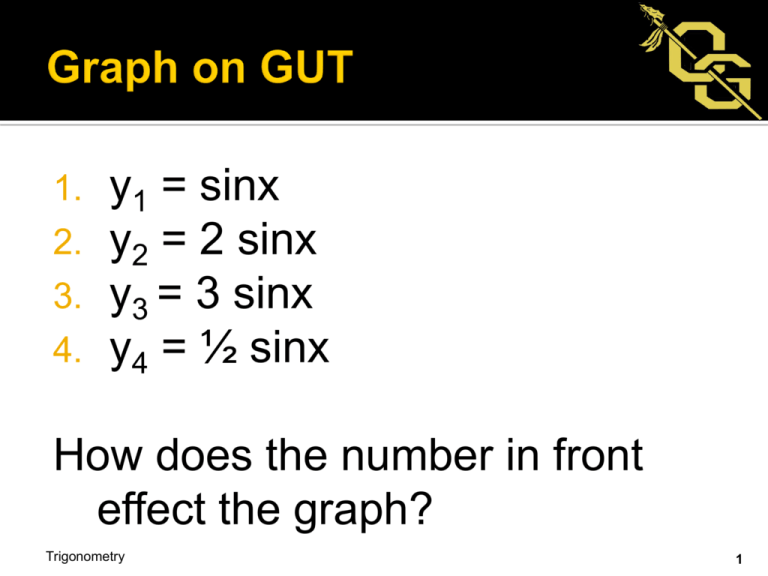Lesson 6.4 - Lamar County School District
advertisement

1. 2. 3. 4. y1 = sinx y2 = 2 sinx y3 = 3 sinx y4 = ½ sinx How does the number in front effect the graph? Trigonometry 1 6.4 Trigonometry Amplitude is defined to be ½ the distance between the lowest and highest points on the graph. The “amplitude” of y = A sin x is |A| Because it is defined to be a distance amplitude is always positive. Trigonometry 3 1. Y = 3 sin x 1. Y = -2 sinx 2. Y = 1/3 cos x 3. Y = - 3/2 cos x What does the negative do to the graph? Reflects over x axis. Trigonometry 4 1. 2. 3. 4. y1 = sin x y2 = sin 2x y3 = sin 3x y4 = sin ½x How does the number in front of x effect the graph? Trigonometry 5 The period is the distance it takes for a graph to “do its thing.” Period of a y = A sin x or y = A cos x is 2π. The period of y = A sin kx or y = A cos kx is 2π/k. If the p < 2π then graph is squished horizontally. If the p > 2π then the graph is stretched horizontally. Trigonometry 6 1. f(x) = 4 cos x A=4 p = 2π 2. f(x) = -2 sin ½ x A=2 p = 4π 3. f(x) = 1/3 cos 2x Trigonometry A = 1/3 p=π 7 Y = ± A sin (kx) Y = ± A cos (kx) Trigonometry 8 1. Y = -3 sin (x/4), -4π < x < 8π A = |-3| A=3 P = 2π/k P = 2π/(1/4) P = 8π Trigonometry 9 2. Y = -2 cos (x/2), -4π < x < 8π A = |-2| A=2 P = 2π/k P = 2π/(1/2) P = 4π Trigonometry 10 3. Y = 1/2 sin (4x), -π < x < π A = |1/2| A = 1/2 P = 2π/4 P = π/2 Trigonometry 11 4. y = 4 sin x, -2π < x < 2π A = |4| A=4 P = 2π/k P = 2π/1 P = 2π Trigonometry 12 5. y = 3 cos (x/4), -π < x < π A = |3| A=3 P = 2π/k P = 2π/(1/4) P = 8π Trigonometry 13 6. Y = 1/3 cos (4x), -π < x < π A = |1/3| A = 1/3 P = 2π/k P = 2π/4 P = π/2 Trigonometry 14 1. A piano tuner strikes a tuning fork for note A above middle C and sets in motion vibrations can by modeled by the equation y = 0.001 sin 880π t. 2. A buoy that bobs up and down in the waves can be modeled by y= 1.75 cos π/3 t. 3. A pendulum can be modeled by the function d= 4 cos 8π t, where d is the horizontal displacement and t is time. Trigonometry 15 Y = ± A cos (kx) |A| = 9.8 A = ±9.8 p = 6π 2π/k = 6π 2π = 6πk ⅓=k Y = ± 9.8 cos ⅓ x or y = ± 9.8 cos x/3 Trigonometry 16 Y = ± A sin (kx) |A| = 4.1 A = ±4.1 p = π/2 2π/k = π/2 4π = πk 4=k Y = ± 4.1 sin 4x Trigonometry 17 Y = ± A cos (kx) |A| = 2 A = ±2 p = π/2 2π/k = π/2 4π = πk 4=k Y = ± 2 cos 4x Trigonometry 18 Y = ± A sin (kx) |A| = 0.5 A = ±0.5 p = 0.2π 2π/k = .2π 2π = .2πk 10 = k Y = ± 0.5 sin 10x Trigonometry 19 Y = ± A cos (kx) |A| = 1/5 A = ± 1/5 p = 2/5 π 2π/k = 2π/5 10π = 2πk 5=k Y = ± 1/5 cos 5x Trigonometry 20 Write an equation of the motion for the buoy assuming that it is at its equilibrium point at t = 0 and the buoy is on its way down at that time. Y = ± A sin kt A = -3.5/2 (negative because it is on its way down) 2π/k = 14 2π = 14k π/7 = k y = -1.75 sin π/7 t Trigonometry 21 Determine the height of the buoy at 8 seconds and at 17 seconds y = -1.75 sin π/7 t y = -1.76 sin π/7 (8) y ≈ 0.75 After 8 seconds, the buoy is about .8 feet above the equilibrium point. y = -1.75 sin π/7 t y = -1.76 sin π/7 (17) y ≈ -1.71 After 17 seconds, the buoy is about 1.71 feet below the equilibrium point. Trigonometry 22 Find the equation of the motion for the buoy assuming that it is at its equilibrium point at t=0 and the buoy is on its way down up at that time. Y = ± A sin kt A = 3/2 (positive because it is on its way up) 2π/k = 8 2π = 8k π/4 = k y = 1.5 sin π/4 t Trigonometry 23 (b) Determine the height of the buoy at 3 seconds. y = 1.5 sin π/4 t y = 1.5 sin π/4 (3) y = 3.18 feet (c) Determine the height of the buoy at 12 seconds. y = 1.5 sin π/4 t y = 1.5 sin π/4 (12) y = 12.73 feet Trigonometry 24 Trigonometry 25 Frequency = 1/period Period = 1/frequency hertz is a unit of frequency, One hertz = one cycle per second Trigonometry 26 |A| = 0.015 A = ± 0.015 P = 1/frequency P = 1/392 P = 2π/k 1/392 = 2π/k K = 784π y = ±A sin kx A = ± 0.015 sin 784πt Trigonometry 27 |A| = 6 A=±6 P = 1/frequency P = 1/.1 P = 10 P = 2π/k 10 = 2π/k 10K = 2π k = π/5 y = ±A sin kx A = ± 6 sin π/5 t Trigonometry 28 State the amplitude and period for f(x) = -2 sin (x/3). 2. Graph y = 2 cos (4x) –π < x < π 3. Graph: y = -3 sin (x/2) 2π < x < 6π 1. Trigonometry 29 Trigonometry 30






